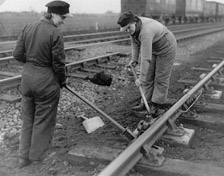This collection consists of photographs of and newsclippings about women railway employees in Britain from before 1915 through the present day. It includes 32 photographs from World War I and 46 photographs from World War II, and a variety of photographs and clippings on topics such as Transport policewomen and individual women’s careers. This site charts a significant history largely undocumented in the historical literature. By the last year of World War I, there were more than 65,000 women employed on railways in Britain. In 1944, at its height, more than 114,000 women worked in the railways.
The site, arranged in 15 sections, is clearly laid out and easy to navigate. The sections include chronological categories; information about site creator Wojtczak, a British historian and former railway employee; a “Railway links” page with links to 14 external sites; and to a section devoted entirely to press clippings.
The sections range widely in scope. Some sections, such as “Railwaywomen around the world,” contain transcribed press clippings. Two sections are devoted to the photographs of World War I and World War II, respectively. Photographs for each period are divided into seven or eight subjects such as “Guards and Signal Women” and “Goods Porters.” Each set of photographs contains a short extract from a relevant contemporary account, including personal testimony of the women involved (sometimes the same women who appear in the photographs). The images are clear and well presented with short captions explaining their content, although the background of sparkling stars in these sections proves an unfortunate and distracting design choice.
The 14 external links are probably of interest mainly to railway enthusiasts, but there are also links to sites concerning women’s history. Those seeking to use this site in a world history context may find the link to the United States Women Veterans site and the forthcoming link to the Women and the American Railroad Research Project useful.
The images and quotations are informative on a variety of levels and describe such things as standards of dress deemed appropriate for the labor involved; technologies of the period; and perceptions of women in the railways, indicated through quotations from contemporary sources such as the Railway Gazette. In particular, the differences between personal memory, images, and official sources such as the Railway Gazette may prove illuminating. The comparison between the first and second world war collections can also be fruitfully explored by teachers and students.
A key disadvantage of this site is the lack of in-depth supplementary material. Nor is the material presented with adequate scholarly rigor. For example, the photographs are mainly unattributed so it is often unclear what their original purpose was (whether for use in government publications, for example, or taken by the subjects themselves). Similarly, the source of personal testimony, such as whether it derives from interviews with Wojtczak herself or from published accounts is unclear.
Nevertheless, this rich site is useful when used with published material to help contextualize the images. Supplementary material that would be helpful for teaching in conjunction with this site is Helena Wojtczak’s forthcoming book Railway Women: The Story of a Forgotten Workforce 1830s-1990s.1 On women and work in wartime Britain, see Deborah Thom, Nice Girls and Rude Girls: Women Workers in World War I,2 Gail Braybon, Women Workers in the First World War: The British Experience3 and Antonia Lant, “The girl that makes the thing that drills the hole that holds the spring...”4
1 Helena Wojtczak, Railway Women: The Story of a Forgotten Workforce 1830s-1990s (Hastings: The Hastings Press, March 2004).
2 Deborah Thom, Nice Girls and Rude Girls: Women Workers in World War I (London: I.B. Tauris, 1998).
3 Gail Braybon, Women Workers in the First World War: The British Experience (London: Croom Helm, 1981).
4 Christine Gledhill and Gillian Swanson, eds., Nationalising Femininity: Culture, Sexuality and British Cinema in the Second World War (Manchester: Manchester University Press, 1996).



